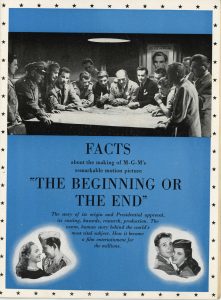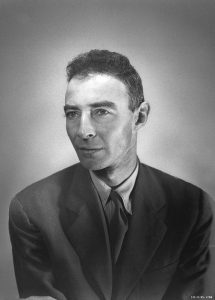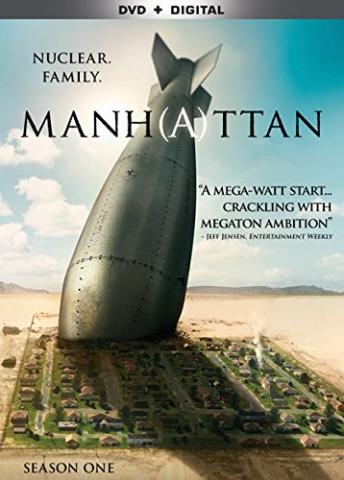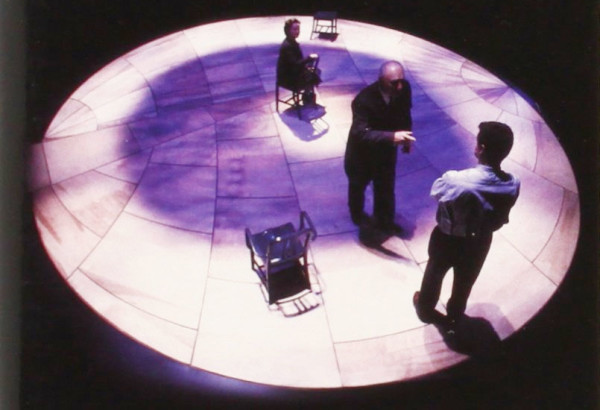The Manhattan Project makes for a tremendous narrative, the story of arguably the most significant technological and scientific achievement in American history. Since 1945, it has frequently appeared in films, fiction, and many other forms of popular culture.
Historical Narratives
One of the first appearance of the Manhattan Project in popular culture was the film The Beginning or the End, released in 1947. As the trailer explains, “The Beginning or the End is the personalized drama of the men and women who bent to their will the savage forces of nature to create the atom bomb. It is the story of how the bomb was made, and when, and where, and why. The Beginning or the End recreates the strange hidden events which have hitherto been spoken of in doubting whispers.”
The film spans the Manhattan Project’s history from the Einstein letter to Chicago Pile-1, development at Los Alamos, and Truman’s decision to drop the bomb. Nevertheless, the scientific details of the film are wildly inaccurate because the secrets of the Manhattan Project were at the time highly classified. It also inaccurately states that leaflets warning Japanese citizens were dropped on Hiroshima for days prior to the bombing, while Nagasaki is not mentioned at all. Harrison Brown, a geochemist who worked at the Met Lab, complained, “Many events are misinterpreted, many of the characters are poorly depicted, and the usual modifications-of-history-to-fit-the-situation have been made.”

Years later, as the secrets of the Manhattan Project became more accessible, other historical dramas were also made. Day One, released in 1989, is probably the most historically accurate Manhattan Project film to date. “It was a day that would change the course of world history forever,” asserts the trailer. “It was a story that many found hard to believe.” A made-for-TV film, Day One would win an Emmy Award for Outstanding Drama/Comedy Special. Scriptwriter David Rintels later explained that he worked hard not to sacrifice history for drama: “Day One does not change how this history is perceived. The real measure in something like this is whether you are responsible to all points of view.”
Fat Man and Little Boy, released the same year, took a different approach. It focuses more on the personalities who made the bomb rather than its history or science and, despite its name, does not show the bombings of Hiroshima and Nagasaki. The film stars Paul Newman as General Leslie Groves and Dwight Schultz as J. Robert Oppenheimer, although their casting was criticized (in part because Newman was supposedly too physically thin to play Groves). The film spends a lot of time on the perceived clash between Groves and Oppenheimer, which was for the most part historically inaccurate.
Film is not the only medium used in popular culture to tell the story of the Manhattan Project. In 2012, Jonathan Fetter-Vorm published Trinity: A Graphic History of the First Atomic Bomb. The book tells the story of the Manhattan Project through comics, going back to the early scientific accomplishments of Ernest Rutherford and Marie Curie.
Fact and Fiction
In recent years, the Manhattan Project has also appeared in popular culture as a blend of fact and fiction. This is particularly true in literature, where the Manhattan Project often appears as a common theme but not as the sole focus. Joseph Kanon’s Los Alamos, first published in 1997, is both a work of historical fiction and a highly gripping murder mystery/spy novel. “Mrs. Rosa Ortiz found the body,” opens the book. The story follows the fictionalized murder of security officer Karl Bruner in Santa Fe, an event which threatens to shut down the Manhattan Project for fear of enemy infiltration.
Nevertheless, it also features prominent Manhattan Project personalities such as Enrico Fermi, General Leslie Groves, and particularly J. Robert Oppenheimer. At the end of the Trinity Test, fictional Mike Connolly warns Oppenheimer that people could hate him for his role in building an atomic bomb. “Well, we’ll see. I’m going to hope for the best,” replies Oppenheimer. As Kanon explained, “Los Alamos is an entertainment, a thriller. To readers, it may simply be a crime story, or a love story, and that’s okay. But to me, underneath it is, or it wants to be, a book about Oppenheimer and the other scientists here in the spring and summer of 1945 when they were only half-consciously about to change human life forever” (Kelly 146).
Another novel, TaraShea Nesbit’s The Wives of Los Alamos, published in 2014, is told from the collective point of view of the women of the Manhattan Project. In the beginning, for example, “Our husbands joined us in the kitchen and said, We are going to the desert, and we had no choice except to say Oh my! as if this sounded like great fun.” It mentions real people such as Oppenheimer, Fermi, and Richard Feynman, but focuses primarily on the unknown women of Los Alamos. It also features real events, such as the Trinity Test: “Through most of our husbands left for the weekend without giving us any clues, one husband, Bernard, told his wife as he held the front door open for a final good-bye, holding his brown bag with two ham sandwiches: You might see something if you stay up all night.”
The fictionalized style of Manhattan Project storytelling has also made its way into television. Manhattan, set in Los Alamos, features mostly fictional characters, such as the protagonist, Frank Winter, and a Chinese-American physicist, Sidney Liao. It also weaves in appearances of real Manhattan Project scientists. Manhattan’s producers worked hard on the show’s historical accuracy and consulted with historian Alex Wellerstein and physicist David Saltzberg. They also used the Atomic Heritage Foundation’s oral history collection as a research tool. Despite mostly positive reviews, Manhattan was canceled in 2016 after two seasons.
Another work related to the Manhattan Project is Michael Frayn’s play Copenhagen. First performed in 1998, the play dramatizes the 1941 meeting in Copenhagen between Werner Heisenberg, the head of the German atomic bomb project, and Niels Bohr, who went on to work on the Manhattan Project. Although the meeting did actually happen, the play also popularized the notion that Heisenberg actively sabotaged the German project despite little evidence of his alleged treachery. In the play, Heisenberg discusses his dilemma (whether to work on the German project) with Bohr, but the playwright leaves it to the audience to decide what Heisenberg actually believed and intended to do. In this way, while not entirely historically accurate, Copenhagen gives a glimpse of the moral quandaries some scientists faced.
Lydia Millet’s 2005 novel Oh Pure and Radiant Heart, also draws from the Manhattan Project. The story revolves around a fictional couple, Ann and Ben, who meet Oppenheimer, Szilard, and Fermi when they appear in contemporary New Mexico. Other recent works of fiction which reference the Manhattan Project include Ellen Klages’ The Green Glass Sea (2008), Jonathan Hickman’s The Manhattan Projects (2012), Adam Gross’ The One Man (2016), and Elizabeth Church’s The Atomic Weight of Love (2017). Additionally, Paul Mullin’s play Louis Slotin Sonata, first produced in 1999, was critically acclaimed.
The Cult of Oppenheimer

In recent years, no Manhattan Project personality has featured more prominently in American popular culture than J. Robert Oppenheimer. Jon Else, the creator of the documentary The Day After Trinity, explained this phenomenon:
Oppenheimer is irresistible to a writer or film producer, because he such a ball of contradictions. We have here a mild-mannered geek who won the Second World War; a frail aesthete, Romantic poet, who was one tough cowboy, who rode horses in the nighttime with the thunder rolling around him through these mountain, probably reciting Baudelaire. We have a misfit with militarism who was utterly at home in the hall of power in Washington. Most of all, we have one of the smartest men… sitting at the very hinge of the 20th century, the use of the bomb in World War II. And that is just too good to pass up if you are an artist or if you are an historian (Kelly 150).
One of the first works to prominently feature Oppenheimer was the 1980 BBC miniseries Oppenheimer, starring Sam Waterston as the title character. The series covers 15 years of his life, beginning in 1938 as Oppenheimer grapples with the rise of fascism and ending with the security hearing which stripped him of his security clearance. The show’s creator, Peter Prince, benefited from relaxed American security protocols and thus was able to obtain more information under the Freedom of Information Act.
Oppenheimer also features prominently in the literature discussed in the previous section. Joseph Kanon, for example, explained, “Robert Oppenheimer walked onto the page, and I had the book. The tools of fiction – plot, a sense of place, atmosphere, et cetera- do not matter without character. Only character brings pages to life. And what a character Oppenheimer was” (145). Millet’s Oh Pure and Radiant Heart features religious undertones that suggest Oppenheimer’s return is the Second Coming. Oppenheimer is “the man in the desert,” the only one who can stop nuclear proliferation. In one scene, a woman even washes his feet, mirroring a scene from the Bible.
 Oppenheimer also appears as the central character of John Adams’ 2005 opera Doctor Atomic. Adams affirmed, “Part of opera’s power is that it is such an absurd art form. You come into a hall, the lights go down, and very bizarre things happen. People enter the stage and start singing in a strangely arch and highly exaggerated way. Frequently the text is unintelligible and the stage changes in a way that is very unlike film” (Kelly 148). The opera’s libretto borrows from primary sources, such as the chorus, which is from the Smyth Report:
Oppenheimer also appears as the central character of John Adams’ 2005 opera Doctor Atomic. Adams affirmed, “Part of opera’s power is that it is such an absurd art form. You come into a hall, the lights go down, and very bizarre things happen. People enter the stage and start singing in a strangely arch and highly exaggerated way. Frequently the text is unintelligible and the stage changes in a way that is very unlike film” (Kelly 148). The opera’s libretto borrows from primary sources, such as the chorus, which is from the Smyth Report:
We believed that
“Matter can be neither
created nor destroyed
but only altered in form.”
We believed that
“Energy can be neither
created nor destroyed
but only altered in form.”
But now we know that
energy may become matter,
and now we know that
matter may become energy
and thus be altered in form.
Adams later made the opera into a three movement symphony. As he explained, “The music is a very sensual experience. I was able to make music that gave a sense of a storm blowing across the desert, of the scientists arguing, of the final countdown and detonation of this weapon” (148).
More recently, Oppenheimer was also featured in Tom Morton-Smith’s 2015 play Oppenheimer. Unlike other portrayals of Oppenheimer, the play showed more of his life, starting with him as a college professor raising funds to fight fascism in Spain.
Legacy
The last ten years have seen a renewed interest in the Manhattan Project, and it will likely continue for the foreseeable future. While this article discussed some of the main appearances of the Manhattan Project in popular culture, many more exist. Among the projects to come is the film The Catcher was a Spy, set to be released later in 2017, which will include the story of the Alsos Mission.







